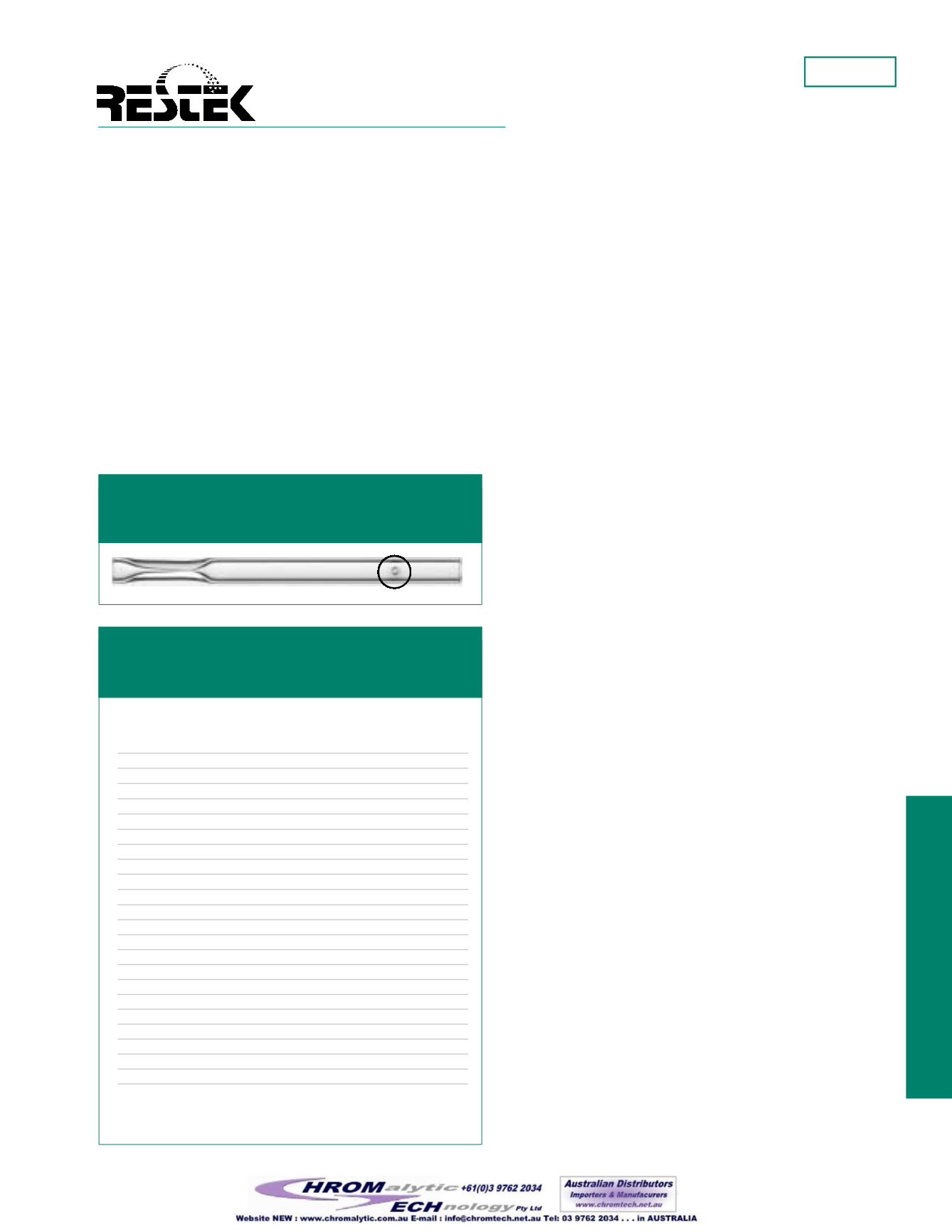
environmental
Applications
note
Restek Corporation • (800) 356-1688 • (814) 353-1300 •
#59487
Higher Responses for ChlorinatedPesticides, Using aDrilledUniliner
®
GC
Inlet Liner andRtx
®
-CLPesticidesColumns
environmental
Inlet reactivity is the primary drawback to using hot flash injection
when analyzing chlorinated pesticides byGC. Residues of heavier
and non-volatilematerials often build up on the inner surface of
the injection port, leaving a reactive surface that can cause com-
pounds such as endrin andDDT to break down.An inlet liner that
makes a press-fit connectionwith the analytical column prevents
analytes from coming in contact with amajor portion of this reac-
tive surface—the bottom of the injection port. The physical con-
nection between the column and the liner also improves the accu-
racy of the analysis, byminimizing injection port discrimination.
Used together, aDrilledUniliner
®
inlet liner (Figure 1), anRtx
®
-
CLPesticides column, and anRtx
®
-CLPesticides2 column ensure
excellent responses in analyses of chlorinated pesticides.Markedly
better results are apparent from comparisons of calibration data
obtained by using aDrilledUniliner
®
inlet liner and anRtx
®
-
CLPesticides/Rtx
®
-CLPesticides2 column pair to data obtained by
using a conventional splitless inlet liner, or by using a conventional
splitless inlet liner packedwith fused silicawool.
Laboratories followingUSEPAMethod 8081 and 8000must docu-
ment the quantification results they generate, to ensure reliability,
precision, and accuracy. Beginningwith a five-point calibration
curve, a calibration factormust be calculated for each analyte. The
relative standard deviation (RSD) for each analyte should be no
more than 20%. In evaluationsmade using aDrilledUniliner
®
inlet
liner, RSD valueswere between 1.0 and 12.5% for anRtx
®
-
CLPesticides column and between 1.2 and 14.2% for anRtx
®
-
CLPesticides2 column (Table 1).
Analysts followingMethod 8081 and 8000 alsomust regularly ana-
lyze and quantify a calibration standard. In the analysis, the con-
centration of each analyte in the calibration standard should be
within ±15% of the “true” value. The accuracy of data obtained
from a system that included aDrilledUniliner
®
inlet liner was test-
edwith a pesticide standardmix at the 20/40/200ng/mL concentra-
tion level (Figure 2). The percent difference from the “true” value
for each analyte ranged from 0 to amaximum of only 6.2%, well
within the acceptable limit. Table 2 summarizes the data.
Because some analytes readily break down as the injection port
inlet becomes contaminated (e.g., endrin andDDT in this analysis),
a performance evaluationmixmust be analyzed and breakdown for
each analyte calculated. Breakdown should not exceed 15%. The
DrilledUniliner
®
inlet liner reduced endrin andDDT breakdown,
relative to the splitless or splitless/wool-packed liners (Table 3),
because the latter liners allow the analytes to contact more of the
reactive surface in the inlet.Wool packing in the splitless liner
makes this problemworse; it greatly increases the surface area
within the liner and introduces additional activity.
In addition to reducing variability and increasing the accuracy of
calibration data, aDrilledUniliner
®
inlet liner increases overall
response for individual analytes, enhancingminimum detection
levels compared to splitless or splitless/wool-packed inlet liners.
This ismost apparent from the area counts for the last eluting peak,
decachlorobiphenyl, whichwere greater by 18–39%, relative to
area counts for injectionsmade on the splitless liners (Table 3).
Finally, aDrilledUniliner
®
inlet liner ensures greater sensitivity,
because less of the injected sample remains in the inlet when the
inlet is swept clean to prepare it for the next sample.
By eliminating the bottom of the injector from the sample pathway,
aDrilledUniliner
®
inlet linermakes the pathwaymore inert. This
reduces breakdown of labile analytes, such as endrin andDDT, and
increases accuracy and precision. For analysts using hot flash
injection techniques in analyses of chlorinated pesticides, or other
labile analytes, these results clearly show that aDrilledUniliner
®
inlet liner is the liner of choice.
Figure 1—The drilled hole in aUniliner
®
injectionport
linermakes direct injection possiblewithEPC systems
by equalizing pressure in the injection port.
Table 1—RSD values for chlorinated pesticides arewell
within acceptable limits (20%) when the inlet is fitted
with aDrilledUniliner
®
inlet liner.
%RSD
%RSD
Rtx
®
-CLPesticides
Rtx
®
-CLPesticides2
Analyte
Column
Column
TCX*
2.3
2.0
α
-BHC
7.8
9.5
γ
-BHC
6.3
5.1
β
-BHC
1.5
2.5
δ
-BHC
8.5
3.3
heptachlor
3.2
11.6
aldrin
2.2
5.6
heptachlor epoxide
4.4
1.2
γ
-chlordane
2.5
1.4
α
-chlordane
3.8
2.9
4,4'-DDE
2.6
5.0
endosulfan I
3.2
2.8
dieldrin
1.0
2.1
endrin
1.7
3.5
4,4'-DDD
4.9
3.9
endosulfan II
3.5
2.8
4,4'-DDT
2.1
1.5
endrin aldehyde
4.8
4.8
methoxychlor
12.5
14.2
endosulfan sulfate
3.4
2.5
endrin ketone
1.9
3.3
DCB**
6.7
6.5
*2,4,5,6-tetrachloro-m-xylene
**decachlorobiphenyl
Columns and conditions listed in Figure 2.


